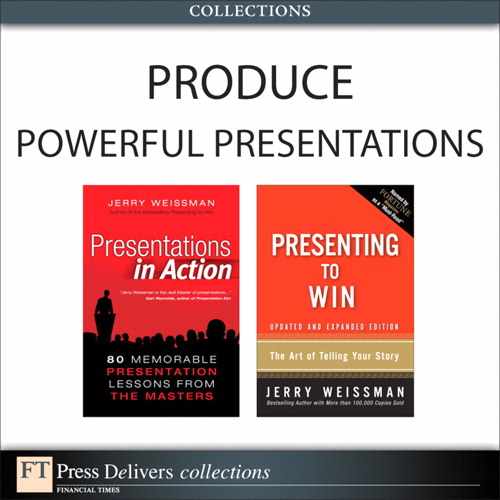Introduction
I see and I remember.
I do and I understand.
Confucius (551 B.C.–479 B.C.)
In the more than two decades I have been a presentations coach, many people have heard me tell them how to present effectively. They have also seen me show them, but the best results have come when I coached my clients to do—to put the techniques into action.
It worked. Those clients’ presentations have raised hundreds of billions of dollars in public, private, and even not-for-profit financing; sold hundreds of thousands of products; formed thousands of partnerships; and gained approval for hundreds of internal projects.
Confucius was right about doing.
The techniques grew out of a variety of sources, going all the way back to my Master’s studies in the Department of Speech and Drama at Stanford University and forward to my days as producer of public affairs programs at WCBS-TV in New York City. Although I didn’t realize it at first, many of the techniques that go into producing a television program are the same as those required to create and deliver a winning presentation: telling a clear and concise story, designing effective graphics, presenting with confidence, and handling tough questions (the latter developed from my CBS assignment at the opposite end of the spectrum of preparing tough questions for the company’s legendary inquisitor, Mike Wallace).
In 1988, I brought the accumulated techniques into the business world, where, after refining and applying them as a coach in the private Power Presentations programs, I made them available to the public in three books: Presenting to Win: The Art of Telling Your Story, The Power Presenter: Technique Style and Strategy, and In the Line of Fire: How to Handle Tough Questions. Taken together, the three books span all the essential elements of any presentation.
An important adjunct to the techniques was to illustrate them with examples of other presentations as lessons of what to do and what not to do. Most of those examples came from my work with prior clients and with public figures. As the years progressed, I accumulated a substantial repertory of case studies from the business world and video clips from the political world. During that same time, I found additional examples in such diverse fields as current events, politics, science, art, music, literature, cinema, media, sports, and even the military. These variations from pure business cases proved to be even more valuable as coaching tools and lessons because they demonstrated the universal aspects of all human communication; in doing so they added significant dimension to the basic techniques.
This book consists of 80 new case studies from the front of the room. They are grouped into five sections mapped to the three original books, where you can find the basic techniques in full:
Section I—Content: The Art of Telling Your Story
Section II—Graphics: The Correct Way to Design PowerPoint Slides
Section III—Delivery Skills: Actions Speak Louder than Words
Section IV—Q&A: How to Handle Tough Questions
Section V—Integration: Putting It All Together
The first two sections relate to Presenting to Win, the third section, The Power Presenter, the fourth, In the Line of Fire, and the fifth incorporates all three books. I am confident that these diverse case studies will give you added depth and dimension for your presentation skills, as well as for all your communication skills. But for the techniques to work most effectively, you must also follow the advice of Confucius—and Nike—and just do it.
